by scott.gillum | Oct 29, 2015 | 2015, Sales
My first job out of college was selling office equipment. The first thing I ever learned about selling (from my very Southern sales manger) was that “Telling ain’t selling.” In layman terms, stop telling customers why they need your product and start listening to their needs.
For years this simple phase remained in my memory. It guided me as a way to engage prospects in advisory-like sales dialogue, probing for a need to sell to. But, after attending CEB’s Sales & Marketing Summit last week, where new research highlighted the increased complexity in reaching a purchase decision, I’m now considering rethinking my whole approach.
Why? Because buyers have become overwhelmed by the potential choices, 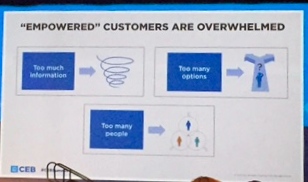 and the involvement of other decision makers in the process, according to Brent Adamson, co-author of The Challenger Customer. Too much information, too many options and too many people involved in the process are making it more difficult than ever to reach a consensus, let alone a purchase decision. Given the complexity, stalled deals are no longer a sales issue; they’re a buying problem.
and the involvement of other decision makers in the process, according to Brent Adamson, co-author of The Challenger Customer. Too much information, too many options and too many people involved in the process are making it more difficult than ever to reach a consensus, let alone a purchase decision. Given the complexity, stalled deals are no longer a sales issue; they’re a buying problem.
The question is: Are marketers contributing to that problem? Is it possible our content marketing efforts, aimed at helping buyers make an informed choice, are becoming part of the “too much” problem? According to Psychologist Barry Schwartz, author of The Paradox of Choice, too much choice often results in no choice at all.
Dr. Schwartz’s research has shown that limiting choice is often necessary to reach a decision, and/or to speed up the buying process. As he said, “When you make choice easier, or more simple, you will sell more.”
For business-to-business sales and marketers, the key is to become “prescriptive,” according to Adamson. Customers need a “trusted advisor” to help guide them through the complexity of the decision making process, in particular in driving a consistent point of view on the problem, and the best solution. Schwartz suggests focusing on the following three areas:
- Be the “expert” or “simplifier.” Help reduce the complexity of the problem, process and/or solution. Smart content should help to explain and simplify solutions to complex problems.
- Create an “anchor.” Help customers understand how to assess the value you offer. Buyers may have a hard time assessing the true value of a new purchase or a new vendor. Help them by giving them context. Find a relatable anchor comparison. Think: ”Platinum service at a standard price.”
- Understand the impact of “no decision.” If no decision is the right decision, then find a way to make it the default answer. This approach is commonly seen in software or subscription-based services where membership/licensing automatically renews.
Do we now dictate to customers/prospects? Not according to Schwartz. Asking probing questions that lead customers to convince themselves that they need your product is the path to goal attainment. Help them understand how your product/service uniquely solves their problem by guiding their path to purchase.
The words of wisdom given to me years ago were right, but given today’s increased complexity it needs an updated “Telling ain’t selling…until it is.”
by scott.gillum | May 11, 2015 | 2015, Marketing
Look at the tweet, then read the graphic. Why is the headline on this tweet by Spencer Stuart, “Majority of marketing leaders want to see data-and analysis driven decision marketing on their teams,” and not “Majority of marketing leaders want to see more creative thinking and exploration on their teams?”
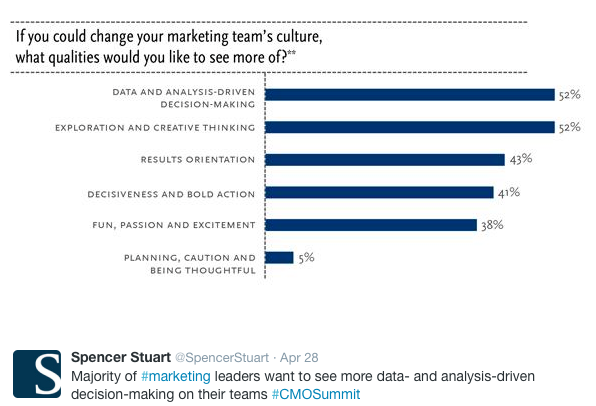
Statistically they’re the same, yet Spencer Stuart emphasized the data/analytic decision making why? “Combine Fun, Passion and Excitement” with “Decision and Bold Action” and you have a solid argument for changing the marketing team’s culture to “Exploration and Creative Thinking.”
On the flip side, only 5% of marketing wants a culture of “Planning, Caution and Being Thoughtful,” amen brother. Ok, I hear you, “if it was “fun” they would call it “play” not work, but maybe we need a little more play at work.
According to Peter Gray, a professor at Boston College and author of Free to Learn, ”play” can be the key that unlocks the mindset of bold creative thinking. In an article on Psychology Today, Gray says that the “alert but unstressed condition” of a playful mind has been shown repeatedly, in psychological experiments, to be ideal for creativity and learning new skills.
“Experiments have shown that strong pressure to perform well (which induces a non-playful state) improves performance on tasks that are mentally easy or habitual for the person, but worsens performance on tasks that require creativity, or conscious decision making, or the learning of new skills.” Although accountants may perform well under pressure, it could be a creativity killer for marketers.
One could conclude then, if an organization too narrowly focuses on “analysis and data driven decision making,” it may come at the expense of “Exploration and Creative Thinking” mentioned in the research and Tweet. Said differently, all work and no play, could make your marketers dull.
Pressure to perform in business marketing is a given, so how do you strike a healthy balance? Stephanie Anderson, CMO of Time Warner Cable’s business division, suggested that by ” focusing on business results first, ensuring that you have a way to show the business impact of marketing activities, you’ll have the foundation in place in order to inject a fun and creativity into the workplace.”
by scott.gillum | Jan 28, 2014 | 2014, Marketing
In December, I had the opportunity to be the Keynote speaker at the Bowery Capital CMO Summit in NYC. The event featured a number of high profile CMO’s speaking with an audience of mostly early stage startups (under 20 employees).
My presentation was based on the recent Forbes blog post Everything We Thought We Knew about B-to-B Marketing in Wrong. The audience also included some local media, a reporter from CMO.com wrote a summary of the speech.
http://vimeo.com/82457497
by scott.gillum | Oct 27, 2013 | 2013, Marketing
What company do customers feel most connected to emotionally?
Apple? Nope. Amazon? Sorry. It must be Nordstrom’s then, right? Not even close. To find the company that has the strongest emotional connection with customers, you have to leave the consumer world behind. Blows your mind, doesn’t it.
According to new research from Google and the CEB, customers are more emotionally connected to B2B brands, and it’s not even close. The company customers say that they are most emotionally connect to is…Cisco.
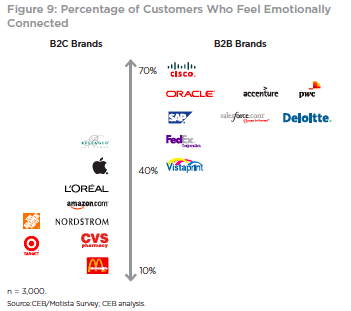
Why? Well, it’s about understanding risk. The more risk involved with a purchase decision, the higher the likelihood of an emotional connection. Increase the variables related to risk (e.g. losing a job, wasting corporate investments) and you have the ingredients for an emotionally involved buyer. Personal risks peak when others are counting on you to make the right decision and the stakes are highest.
How did Cisco become number 1? It has to do with Cisco’s ability to reduce risk with buyers. Forrester ‘s Evaluate Your Channel Partner Loyalty Program, surveyed over 250 hi-tech business partners to understand the drivers of loyalty. Partners were asked to select the reason/s “why their most strategic vendor is their most important vendor” (see the table below).
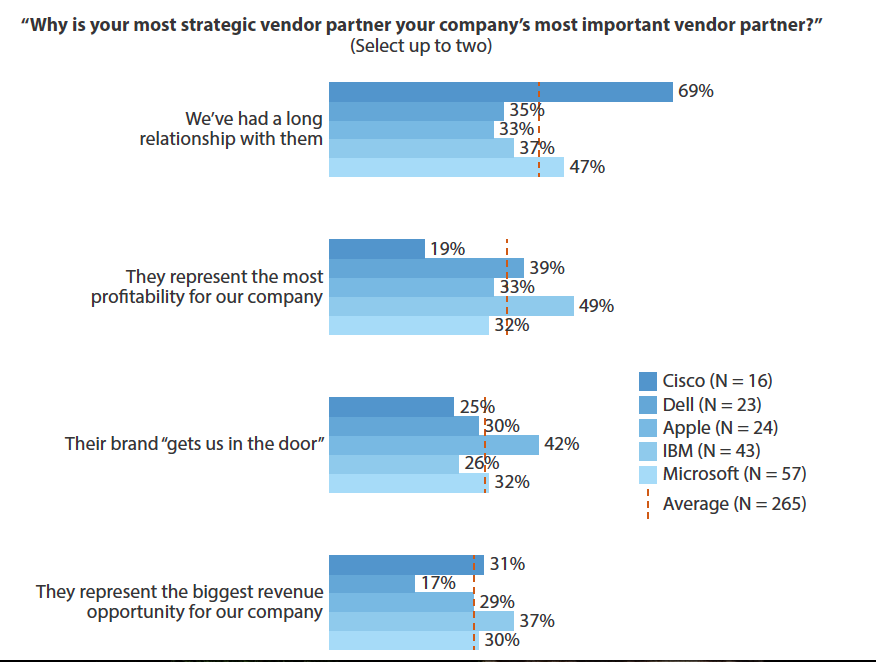 Partners, buyers of Cisco gear, selected Cisco for the strength of the relationship, despite that fact that Cisco was also the most profitable vendor (established earlier in the research). Cisco partners value the relationship more highly than other partners, 26% more.
Partners, buyers of Cisco gear, selected Cisco for the strength of the relationship, despite that fact that Cisco was also the most profitable vendor (established earlier in the research). Cisco partners value the relationship more highly than other partners, 26% more.
The reason is related to how Cisco is able to create and communicate what the CEB and Google research describes as “personal value” consisting of four parts; professional, social, emotional and self-image benefits. Some of which are communicated, others realized through the customer experience. For example, existing customers understand the “personal value” associated with an existing vendor 2X that of non-customers.
Cisco has built a strong “personal value” equation by investing heavily in their partner’s success. It supports them professionally through training and certification programs. Invest in the brand to support the emotional bond and self-image, and in sales and marketing activities to drive demand.
All of which reduces the risk associate with failure, be it personally or professionally. And in return, they trust Cisco with their livelihood, valuing the “Relationship” above rational drivers, like profits and revenue.
Getting Personal and Emotional
How can we leverage this insight? To start, focus on better communicating “personal value” to non-customers. The research found that brand messaging connects with buyers early on, but the excitement wanes over time as we move down the buyer journey into the evaluation phases.
The rational brain takes over to assess risk, and the complications associated with the purchase, at this point as much as 50% of the potential deals stall or fall out of the process. Risk impacts their initial positive emotions, and unfortunately, we don’t much to help them.
To counter those feelings engage them with personal-value messaging, go beyond just using feature/functionality language (functional benefits) to describe products or services by combining the emotional and self-expressive benefits as well (see below).
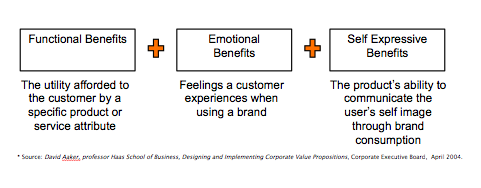
Like Cisco, understand how your products or services impact buyers. Does it make them feel “smarter” by having the latest technology, or more “secure” in their role. Although buyers are individuals with unique personalities, and should be treated that way, they most likely share the same fears, uncertainties, and doubts we have in our roles.
Get to know them, like you know yourself. Stop assume they are always rational and buy on price and/or functionality. And finally, realize that there are customers who are emotionally connected to your brand, and/or highly value their relationship with your organization, and when they say that they “love your product or company”…they actually might just mean it.
by scott.gillum | Jun 10, 2013 | 2013, Marketing
 This time of year, America’s third or fourth (depending on where you live) most popular sport gets its moment in the sun. The Stanley Cup finals begin this week and the nation’s attention turns to ice, hockey sticks, pucks, and maybe mullets.
This time of year, America’s third or fourth (depending on where you live) most popular sport gets its moment in the sun. The Stanley Cup finals begin this week and the nation’s attention turns to ice, hockey sticks, pucks, and maybe mullets.
For business marketers, the “holy grail,” or in this case the “Stanley Cup,” has been trying to demonstrate the business impact of social media. Not defined by adoption, usage, or engagement, but by influence. Proving that social media and/or social networks can influence buyer behavior. New insight suggests that it might be time to lace up the skates and put on the pads.
Word of mouth (WOM), defined by person-to-person communication be that in person or over the phone, is and has always been the most used, and most influential channel for business buyers. Sometimes also described and measured as NPS (Net Promoter Score), it is the “Wayne Gretsky” of driving influence among decision makers, both in new acquisition, and for renewal.
Unlike WOM, Social Media has struggled with demonstrating influence. Adoption and usage rates continue to grow, but the impact on B2B decision makers has been difficult to nearly impossible to measure (btw – this is not unlike other, more established media channels).
That was until now. Research from Buyersphere may give us a clue to how social media may influence decision makers in the near future, and it has given us a couple of “hockey sticks” and a “puck” to play with.
According to Buyersphere’s Annual Survey of B2B Buyer Behavior, even though buyers mention social media (and providers such as Twitter, Facebook and Linkedin) when asked to rate their usage and the usefulness of channels when searching for vendors, they fall off the grid when asked to evaluate their influence. As you would expect, word of mouth came out on top.
Diving deeper into the research, it revealed a few game changing findings. Twenty to thirty year olds (Gen Y), act like no other previous generations. The first “hockey stick” is somewhat known — twenty-something business buyers are roughly twice as likely to seek information or advice from social media as the generation before them (31-40 year olds). And almost four times more likely to than the baby boomers (51-60 year olds).
 The second hockey stick, and the one that may end up being somewhat problematic for marketers, is that 49% of Millennials stated that they wanted to create and publish their own professional content. They not only want your content, but they also want to be able to disassemble it and repackage it with their own point of view.
The second hockey stick, and the one that may end up being somewhat problematic for marketers, is that 49% of Millennials stated that they wanted to create and publish their own professional content. They not only want your content, but they also want to be able to disassemble it and repackage it with their own point of view.
And finally, the puck to play with is that buyers under 30 are the only group that describe word of mouth as social media first, and then phone or in person. Close to 50% of Gen Y buyers defined WOM as any social media, in person or phone, mentioned by only 33% of the respondents. Buyers 40-50 by contrast, define WOM as in person or phone 60% of the time with any social media platform only 23%.
Game On
Marketers most powerful and influential channel is now being redefined, and this presents the best opportunity to date to demonstrate the impact of social media on buyer behavior. “To skate to where the puck is going to be” as Gresky used to say, we need to plan now.
To define the approach we need to understand the components of “social media” that are often lumped together – social networks and social media. Social networks refer to the connection among users and their social structure (friend, business acquaintance, etc.).
Social media is defined as the online channel used to generate, access and distribute content. The distinction is important because of the way different generations of business buyers use and value them. This is key to unlocking influence.
We know that their social network heavily influences Gen Y, more than any other generation. We know that half of them want to produce and share their own content, 60% upload content to the web, and 62% rate products and services on the web.
So for Enterprise accounts, where Gen Y is 5-10 years from occupying the C-Suite, take a lesson from McDonalds and “grow your own customers.” Get Gen Y hooked on your content by involving them in your brand and making your content modular so it’s easy to repackage and share. The route to influence is through cause marketing efforts delivered via mobile devices. Thirty-seven percent of Millennials say they are drawn to products with co-branded campaigns.
For small businesses, which Gen Y owns close to 1 out of 3, according to the Executive Council of Small Business (ECSB), the goal should be to make them advocate for your brand, product or services to their network. To do that, focus on issue resolution, the number one loyalty driver. For prospects, provide them with information that is useful.
According to the ECSB, the number one pain point for all small business owners is sales and customer acquisition; being twice as prevalent among Gen Y owners. Specifically, lead generation and successfully competing with other small business owners. Help them understand how your products and services can help them grow their business.
Even though there is potential for social media to deliver a real, tangible business impact, it will be similar to this championship series. It’s not going to be quick, expect to lose a game or two along the way, and to be successful you’ll need to take many shots on goal…hell, you may even lose a tooth or get a “shiner.”
 and the involvement of other decision makers in the process, according to Brent Adamson, co-author of The Challenger Customer. Too much information, too many options and too many people involved in the process are making it more difficult than ever to reach a consensus, let alone a purchase decision. Given the complexity, stalled deals are no longer a sales issue; they’re a buying problem.
and the involvement of other decision makers in the process, according to Brent Adamson, co-author of The Challenger Customer. Too much information, too many options and too many people involved in the process are making it more difficult than ever to reach a consensus, let alone a purchase decision. Given the complexity, stalled deals are no longer a sales issue; they’re a buying problem.











